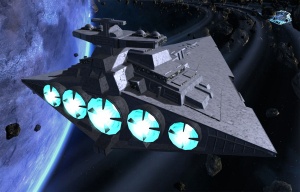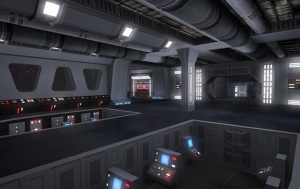| File:Brotherhoodclass.jpg
|
| Brotherhood-class Star Dreadnaught
|
|
Kuat Drive Yards
|
|
Dreadnaught
|
|
Brotherhood-class
|
|
~405,640,000
|
|
3,200 meters
|
- Class One
- Backup: Class Ten
|
|
Verpine Navigator SPS
|
- Heavy turbolasers (70: 20 fore, 10 aft, 20 port, 20 starboard)
- Turbolasers (88: 20 fore, 20 aft, 24 port, 24 starboard)
- Ion cannons (40: 7 fore, 7 aft, 13 port, 13 starboard)
- Proton torpedo tubes (8, turreted)
- Assault concussion missile tubes (10, turreted)
- Tractor beam projectors (8: 3 fore, 2 port, 2 starboard, 1 aft)
|
- 144 Starfighters
- 35 shuttles & aux craft
|
|
|
|
3,000
|
|
12,500 troops
- Prefabricated garrison base
|
|
45,000 metric tons
|
|
6 years
|
|
Dark Jedi Brotherhood Era
|
The Brotherhood-class Star Dreadnought is the largest of the five classes of warships gained by the Dark Brotherhood through Operation Tempest Bravo in 24 ABY. Based on the hull of the Clone Wars era Praetor-class Star Battlecruiser, the class is an excellent multi-role platform and can easily standing toe to toe with similar vessels fielded by the Galactic Alliance. The single Brotherhood-class vessel constructed, Nightfall, serves as command ship of the Navy of the Iron Throne.
Characteristics
Dimensions
 Brotherhood-class aft.
Brotherhood-class aft.The 3,200 meter hull of the Brotherhood-class has roughly the same proportions and hull layout as the ubiquitous Imperial-class destroyers. The most obvious difference is the larger superstructure atop the dorsal surface of the hull. This superstructure emerges from the main hull much farther forward of where it begins on the Imperial-class, and has larger terrace structures climbing towards the main bridge tower at the aft.
Like many larger star dreadnaughts, the Brotherhood-class mounted an oversize reactor system deep within the hull. As a result, the protruding reactor bulge found in other destroyer-type ships was absent. The reactor systems also fed the large main engines found along the aft. The engine array mirrored that found in designs such as the Executor-class by omitting secondary engine systems of varied sizes and instead incorporating a large bank of similarly sized main engines. The five engines of the Brotherhood-class are of slightly different size and provide differing levels of thrust output, but they are all based on the same basic engine system.
Crew Requirements
When the engineers of Sienar Fleet Systems worked to adapt the existing Praetor design to meet the Brotherhood’s needs, one of the first areas they attempted to address was the massive crew originally needed to operate the vessel. Like most capital ships of the Clone War era, the Praetor had a far larger crew then comparable modern vessels. Using greater levels of automation and droid support, this number was reduced to just under fifty-five thousand. The Brotherhood-class design also incorporates expanded crew support and recreational facilities to accommodate long duration mission deployments.
Offensive and Defensive Systems
Unlike many Star Dreadnaughts, the Brotherhood-class does not carry what many would consider an overwhelming number of energy weapons. While twice the size of an Imperial-class Star Destroyer, the Brotherhood-class carries substantially fewer then twice the complement of turbolasers and ion canons. The ship instead mounts extensive missile and torpedo systems, the goal of which is to inflict catastrophic damage quickly with massed projectile fire when the ship's energy weapons bring down the shields of an opposing vessel, even if only for a limited duration.
What the Brotherhood-class may lack in offensive punch with its energy weapons when compared to other vessels of its class, it more then makes up for in defensive systems. One of the major reasons to favor the torpedo systems, with their lower energy demands, over expanding turbolaser or ion canon systems was to direct more energy power to the deflector shields. The Praetor design upon which it is based already fielded an impressive shield capacity, and the Brotherhood-class design expands on this using newer technology and more raw power. In addition to shield systems second to none, the Brotherhood-class also mounts equally heavy armor. The Brotherhood-class uses Doonium like most starship designs, but adds heavy durasteel plating that is half again the thickness used to armor Imperial-class vessels. This armor combined with the shield systems means the Brotherhood-class can stand toe to toe with entire squadrons of destroyer class vessels and easily hold off even larger Star Dreadnaughts.
Complement
To supplement its own offensive systems the Brotherhood-class carries a fighter complement of two full Imperial wings totalling 144 starfighters. The flight decks are optimized to host larger, hyperspace capable designs as opposed to less effective fighter craft such as the TIE/ln or TIE/sa. These craft are also tasked with ensuring the safety of the vessel’s landing craft and shuttles during planetary assault and boarding operations.
In addition to starfighters and other auxiliary craft, the vessel also fields a large ground force of 12,500 men. The vessel also embarks full mechanized and armored support for the infantry complement, giving the Brotherhood-class the ability to engage in full planetary assault operations without further support.
History
Origin
 The bridge of a Brotherhood-class Dreadnaught.
The bridge of a Brotherhood-class Dreadnaught.The Praetor-class design that would serve as the basis for the Brotherhood-class Star Dreadnaught began as a sector defense vessel created by Republic Sienar Systems during the waning days of the Galactic Republic. Serving a similar role to the Procurator-class Star Battlecruiser, the Preator was of similar capabilities of other large vessels of the time, but was however limited to local hyperdrive ranges. Many were built and saw service with the Allied Tion sectorial defense fleets, seeing combat throughout the sector when the governments of the Allied Tion sector shifted their allegiance to the Confederacy of Independent Systems. Following the end of hostilities Republic Sienar Systems was dissolved and its assets, including the remaining Preator-class vessels, were absorbed into the new Imperial Navy. They saw limited service, eventually being replaced by newer Imperial-class vessels.
Sienar Fleet Systems inherited the Praetor design along with all the other assets of the former Republic Sienar Systems, but it would languish in databases for decades thereafter as Sienar shifted predominately to starfighter production as opposed to that of capital warships. This all changed in 25 ABY when the Brotherhood entered into negotiations with Sienar in order to secure starfighters and preferred trade status for the procurement of starship components for the new capital vessels to be constructed by Kuat Drive Yards.
The Brotherhood’s representatives had been instructed to also attempt to procure access to any starship designs that would suit the needs of the Navy of the Iron Throne, and the Praetor was perfect. They had been looking at production of a vessel based on the Allegiance-class design of KDY, but the Praetor was better suited their design needs. Additionally, with the Brotherhood being able to purchase the design outright from Sienar, they avoided having to pay additional licence fees to KDY for production.
Service
Due to size and complexity, the Brotherhood-class Nightfall was the first of the Tempest Bravo vessels to begin construction and nearly the last to be completed. The Nightfall was then transferred to Roche along with the rest of the operational vessels for final fitting out. These upgrades focused mainly on defensive systems and included sensor upgrades and ion shielding. The Nightfall was then delivered to the Navy of the Iron Throne and commissioned into service as the fleet’s command ship.